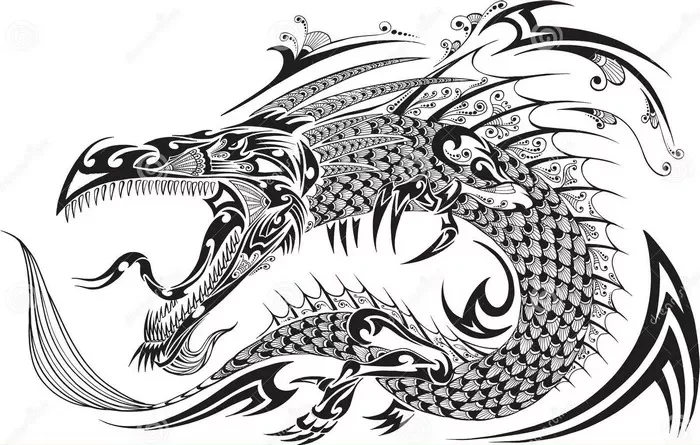Dragon tattoos have long fascinated art enthusiasts and tattoo lovers alike, particularly in Eastern cultures where they carry deep symbolic meanings. While both Chinese and Japanese dragons are celebrated for their mythical and spiritual significance, they differ in design, symbolism, and cultural context. This article explores these differences, shedding light on what makes each type unique, and helps you understand which dragon tattoo may resonate more with your personal aesthetic and beliefs.
The Cultural Significance of Dragons
Chinese Dragons
In Chinese culture, dragons are revered as symbols of power, strength, and good fortune. Unlike their Western counterparts, which are often depicted as malevolent creatures, Chinese dragons are considered benevolent and wise beings. They are associated with water and are often depicted as controllers of rainfall and floods, essential for agriculture.
Key Characteristics:
Benevolent Nature: Chinese dragons are seen as protectors and bringers of good luck.
Elemental Association: They are often linked to water, storms, and fertility.
Symbol of the Emperor: Historically, the dragon was a symbol of imperial authority, representing the emperor’s divine right to rule.
Japanese Dragons
Japanese dragons, while sharing some similarities with their Chinese counterparts, have distinct characteristics and associations. They are often seen as water deities and are linked to storms and agriculture as well. However, Japanese dragons can also embody dualities, representing both good and evil.
Key Characteristics:
Complex Nature: Japanese dragons can embody both benevolence and malevolence, often representing a balance of dualities.
Connection to the Sea: They are associated with oceans and rivers, embodying the powerful forces of nature.
Mythological Influence: Influenced by Buddhism and Shintoism, Japanese dragons are seen as protectors and sometimes depicted as guardians of temples.
See Also: Fierce and Feminine: Dragon Tattoo Ideas for Women
Design Differences Between Chinese and Japanese Dragon Tattoos
Chinese Dragon Tattoos
Chinese dragon tattoos typically feature long, serpentine bodies with a more ornate design. Here are some distinctive design elements:
Body Shape: Chinese dragons are often depicted as long, winding creatures, resembling a snake-like form.
Facial Features: They have wide, rounded heads with long whiskers, large eyes, and often possess antler-like horns.
Scale Patterns: The body is covered in intricate scale patterns, emphasizing their serpentine nature.
Symbolic Accessories: Chinese dragon tattoos often include clouds, waves, or pearl symbols, representing power and the dragon’s control over water.
Japanese Dragon Tattoos
Japanese dragon tattoos tend to have a more robust and muscular appearance, with unique design traits that set them apart:
Body Shape: While also serpentine, Japanese dragons can have shorter, stockier bodies compared to their Chinese counterparts.
Facial Features: They often feature more defined jawlines, fierce expressions, and smaller eyes, contributing to a more intimidating appearance.
Scale Patterns: Japanese dragons may have larger, more pronounced scales, often emphasizing their strength and agility.
Cultural Symbols: In addition to clouds and water, Japanese dragon tattoos frequently incorporate cherry blossoms, waves, and other traditional Japanese motifs, representing beauty and impermanence.
Symbolic Meanings of Dragon Tattoos
Chinese Dragon Tattoo Symbolism
Chinese dragons symbolize several key attributes:
Power and Strength: Representing authority and power, these dragons convey the strength of the emperor and the ruling class.
Good Fortune: They are often associated with good luck, prosperity, and positive energy.
Protection: Chinese dragons are seen as protectors, warding off evil spirits and ensuring safety.
Japanese Dragon Tattoo Symbolism
Japanese dragons carry their own unique meanings:
Balance: Representing the balance of good and evil, they symbolize the duality of nature and life.
Wisdom: Often associated with ancient wisdom and knowledge, they embody the connection to the spiritual realm.
Transformation: Japanese dragons can signify transformation and renewal, often linked to the myth of dragons transforming into benevolent beings after overcoming challenges.
Placement Preferences for Dragon Tattoos
Chinese Dragon Tattoos
Due to their elongated shape, Chinese dragon tattoos are often placed in areas that allow for their full design to be displayed:
Back: The back is a popular canvas, allowing for a large, detailed depiction that can flow from the shoulders down.
Sleeves: Dragon tattoos can wrap around the arms, creating a dynamic and eye-catching effect.
Japanese Dragon Tattoos
Japanese dragon tattoos, with their robust design, also have preferred placements that enhance their aesthetic:
Upper Arm: Often inked on the upper arm or bicep, allowing the dragon to wrap around the muscle, showcasing strength.
Thigh: The thigh provides ample space for intricate designs, allowing for full-body representations.
Conclusion: Choosing Between Chinese and Japanese Dragon Tattoos
When considering a dragon tattoo, understanding the cultural significance, design elements, and personal symbolism behind each type is crucial. Chinese dragons offer a representation of power and good fortune, while Japanese dragons embody a balance of duality and transformation.
Both designs are rich in history and meaning, making them excellent choices for anyone looking to express their individuality through body art. Ultimately, the choice between a Chinese and a Japanese dragon tattoo comes down to personal preference, aesthetics, and the meanings you wish to convey through your ink.
Whether you’re drawn to the flowing elegance of a Chinese dragon or the fierce strength of a Japanese dragon, both tattoos celebrate the timeless allure of these mythical creatures. As you embark on this journey of self-expression, take the time to explore the symbolism and artistic nuances that resonate with your identity, ensuring your tattoo reflects your unique story.
You Might Be Interested In

